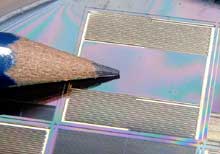Marsquake detection sensors will take search for water underground

A microseismometer machined out of a single piece of silicon. The central rectangular weight is attached by two springs to a surrounding frame. <br>© Imperial College of Science, Technology and Medicine
Researchers at Imperial College London have just begun a 5-year project to design and build tiny earthquake measuring devices to go to Mars on the 2007 NetLander mission.
Unlike the instruments on next year`s European Mars Express/Beagle II mission, the Marsquake sensors will be the first to look deep inside the planet.
The internal structure of Mars is a key to understanding some fundamental questions about the planet including whether life ever existed there.
The sensors are capable of detecting liquid water reservoirs hidden below the surface, where life could possibly survive on Mars today. The recent discovery by the Mars Odyssey orbiter of large amounts of ice at the poles opens up the possibility of liquid water existing in the warmer conditions underground near the Martian equator.
Dr Tom Pike, of Imperial College London, is designing the heart of the sensor, a two-centimetre square of silicon.
“We`re micromachining a near-perfect spring and weight from a single piece of silicon. We`ll be able to detect the weight shuddering in response to a Marsquake from anywhere on the planet,” he said.
The 2007 NetLander mission, led by the French space agency, CNES, will land four modules across the surface of Mars, each containing instruments to look at the structure and weather of Mars on a global scale. All four will be near the equator.
“The network of instruments will help us to pinpoint each Marsquake by triangulation,” said Dr Pike. “We`ll look at how the vibrations from Marsquakes travel through the planet and work out what`s going on deep inside. If these vibrations hit liquid water under the landing sites, we should see a distinctive signature. That`s when the search for life on Mars will move underground.”
Dr Pike is currently building up the team at Imperial College to develop the sensors under a contract from the Jet Propulsion Laboratory. The Rutherford Appleton Laboratory, Oxfordshire, is providing the fabrication facilities. The Marsquake instrument consortium includes Imperial College, NASA`s Jet Propulsion Laboratory in Pasadena, the Institute de Physique du Globe in Paris and ETH, Zurich.
Media Contact
All latest news from the category: Earth Sciences
Earth Sciences (also referred to as Geosciences), which deals with basic issues surrounding our planet, plays a vital role in the area of energy and raw materials supply.
Earth Sciences comprises subjects such as geology, geography, geological informatics, paleontology, mineralogy, petrography, crystallography, geophysics, geodesy, glaciology, cartography, photogrammetry, meteorology and seismology, early-warning systems, earthquake research and polar research.
Newest articles

You are What You Eat—Stanford Study Links Fiber to Anti-Cancer Gene Modulation
The Fiber Gap: A Growing Concern in American Diets Fiber is well known to be an important part of a healthy diet, yet less than 10% of Americans eat the minimum recommended…

Trust Your Gut—RNA-Protein Discovery for Better Immunity
HIRI researchers uncover control mechanisms of polysaccharide utilization in Bacteroides thetaiotaomicron. Researchers at the Helmholtz Institute for RNA-based Infection Research (HIRI) and the Julius-Maximilians-Universität (JMU) in Würzburg have identified a…

ASXL1 Mutation: The Hidden Trigger Behind Blood Cancers and Inflammation
Scientists show how a mutated gene harms red and white blood cells. LA JOLLA, CA—Scientists at La Jolla Institute for Immunology (LJI) have discovered how a mutated gene kicks off…



